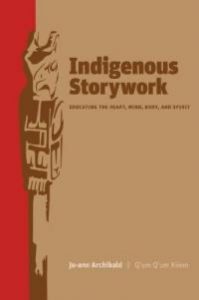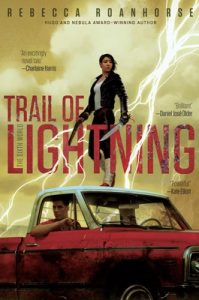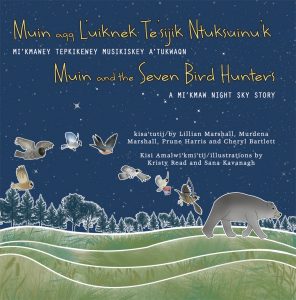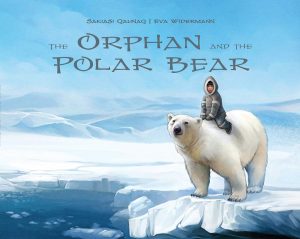This month’s Indigenous Ground Floor Display theme is Indigenous Storywork. The books in the display reflect the rich storytelling traditions of Indigenous peoples across North America. There are examples of traditional stories, young adult dystopias, graphic novels, and scholarship on the topic of storywork. Be sure to check out the display!
Indigenous Storywork by Jo Ann Archibald (Q’um Q’um Xiiem)
 This book describes the author’s journey to learn about “the ‘core’ of Indigenous storytelling from Elders” and how to respectfully incorporate stories and storytelling into education and curricula more broadly. Working with Coast Salish Elders and Stó:lō Elders, Archibald learned about ways to become a storyteller through helping people “think, feel and be through the power of stories.” Archibald also learned that there are seven principles for using First Nations stories in an educational context—what the author termed storywork—and how stories can take their own life and become the teacher if these principles are used. Throughout the book, the author discusses topics such as storywork principles, her research methodology with the Elders, the teachings of the Stó:lō Elders and how to create a culturally appropriate pedagogy. As such, this book is an excellent resource for teachers looking to incorporate Indigenous perspectives in their classrooms.
This book describes the author’s journey to learn about “the ‘core’ of Indigenous storytelling from Elders” and how to respectfully incorporate stories and storytelling into education and curricula more broadly. Working with Coast Salish Elders and Stó:lō Elders, Archibald learned about ways to become a storyteller through helping people “think, feel and be through the power of stories.” Archibald also learned that there are seven principles for using First Nations stories in an educational context—what the author termed storywork—and how stories can take their own life and become the teacher if these principles are used. Throughout the book, the author discusses topics such as storywork principles, her research methodology with the Elders, the teachings of the Stó:lō Elders and how to create a culturally appropriate pedagogy. As such, this book is an excellent resource for teachers looking to incorporate Indigenous perspectives in their classrooms.
Trail of Lightning by Rebecca Roanhorse
 This story takes place in a world that has drowned in the waters of a climate apocalypse, known as the Big Water. In this world, Dinétah (formerly the Navajo reservation) was reborn. Maggie Hoskie is a Dinétah monster hunter who uses her clan powers to help her in her grisly hunts, as the rebirth of Dinétah also meant the return of monsters, gods, and heroes. One of Maggie’s hunts leads her to face off against a monster who was created by witchcraft, and so she embarks on a journey to find out who is making these monsters and stop them. She is joined by Kai, and together they encounter friends, tricksters, gods and an old mentor. Trail of Lightning is an exquisitely written young adult novel with a female Indigenous main character who is only concerned with keeping herself alive.
This story takes place in a world that has drowned in the waters of a climate apocalypse, known as the Big Water. In this world, Dinétah (formerly the Navajo reservation) was reborn. Maggie Hoskie is a Dinétah monster hunter who uses her clan powers to help her in her grisly hunts, as the rebirth of Dinétah also meant the return of monsters, gods, and heroes. One of Maggie’s hunts leads her to face off against a monster who was created by witchcraft, and so she embarks on a journey to find out who is making these monsters and stop them. She is joined by Kai, and together they encounter friends, tricksters, gods and an old mentor. Trail of Lightning is an exquisitely written young adult novel with a female Indigenous main character who is only concerned with keeping herself alive.
 The story of Muin and the Seven Bird Hunters is an old Mi’kmaw legend. Muin, the Black Bear, wakes from hibernation and goes in search of food. Juki’kes (Chickadee), Jipjawej (Robin), Nikjako’kej (Gray Jay), Ples (Passenger Pigeon), Tities (Blue Jay), Ku Ku Kwes (Barred Owl) and little Kupkwe’j (Northern Saw-whet Owl) notice Muin and begin to chase her, because they are Ntuksuinu’k—the Hunters. Muin is eventually shot by Jipjawej, and her blood is how the maples got their blood-red leaves. The blood is also how Jipjawej received the red patch on his chest. In winter, Muin’s skeleton can be found on its back in the sky, and this marks the time of the Mi’kmaw people’s Midwinter Ceremony, the most important of the year. This book is an excellent tool for teachers who wish to teach about Indigenous legends and Indigenous languages.
The story of Muin and the Seven Bird Hunters is an old Mi’kmaw legend. Muin, the Black Bear, wakes from hibernation and goes in search of food. Juki’kes (Chickadee), Jipjawej (Robin), Nikjako’kej (Gray Jay), Ples (Passenger Pigeon), Tities (Blue Jay), Ku Ku Kwes (Barred Owl) and little Kupkwe’j (Northern Saw-whet Owl) notice Muin and begin to chase her, because they are Ntuksuinu’k—the Hunters. Muin is eventually shot by Jipjawej, and her blood is how the maples got their blood-red leaves. The blood is also how Jipjawej received the red patch on his chest. In winter, Muin’s skeleton can be found on its back in the sky, and this marks the time of the Mi’kmaw people’s Midwinter Ceremony, the most important of the year. This book is an excellent tool for teachers who wish to teach about Indigenous legends and Indigenous languages.
The Orphan and the Polar Bear retold by Sakiasi Qalinaq and illustrated by Eva Widermann
 In the North, there lived people who hunted walrus with harpoons. When the men left the camp for these hunts, an orphan often joined. He would leave with the men, but he would not return home with them, for he was always left behind. On one of these occasions, a polar bear followed the orphan home. The polar bear was also a man, in fact he was an Elder, and he brought the orphan far away to the polar bear camp. While at the camp, the orphan trained to become a capable hunter and learned how to stand up for himself. Once the orphan had learned everything there was to know, the polar bear returned him to the place where they met and the orphan returned to his village. This book and its beautiful illustrations contain many themes and values of the Inuit people, and is therefore an excellent resource for teachers looking to add Inuit perspectives to their classrooms.
In the North, there lived people who hunted walrus with harpoons. When the men left the camp for these hunts, an orphan often joined. He would leave with the men, but he would not return home with them, for he was always left behind. On one of these occasions, a polar bear followed the orphan home. The polar bear was also a man, in fact he was an Elder, and he brought the orphan far away to the polar bear camp. While at the camp, the orphan trained to become a capable hunter and learned how to stand up for himself. Once the orphan had learned everything there was to know, the polar bear returned him to the place where they met and the orphan returned to his village. This book and its beautiful illustrations contain many themes and values of the Inuit people, and is therefore an excellent resource for teachers looking to add Inuit perspectives to their classrooms.
All of these books can be found in the glass display case across from the Reference Desk on the Ground Floor of the Library. Please do not hesitate to open up the case and check out books, or ask the Reference or Circulation Desk for assistance.
